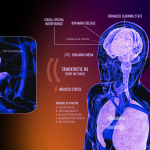
Senior author Mohammad Malakooti, of the University of Washington, said: “I had this vision a long time ago.
“When you put this device on your skin, it uses your body heat to directly power an LED. As soon as you put the device on, the LED lights up. This wasn’t possible before.”
This device was designed from scratch. The researchers started with simulations to determine the best combination of materials and device structures and then created almost all the components in the lab.
It has three main layers. At the center are rigid thermoelectric semiconductors that do the work of converting heat to electricity. These semiconductors are surrounded by 3D-printed composites with low thermal conductivity, which enhances energy conversion and reduces the device’s weight.
To provide stretchability, conductivity and electrical self-healing, the semiconductors are connected with printed liquid metal traces. Additionally, liquid metal droplets are embedded in the outer layers to improve heat transfer to the semiconductors and maintain flexibility because the metal remains liquid at room temperature.
In addition to wearables, these devices could be useful in other applications, Malakooti said.
“You can imagine sticking these onto warm electronics and using that excess heat to power small sensors.
“This could be especially helpful in data centers, where servers and computing equipment consume substantial electricity and generate heat, requiring even more electricity to keep them cool. Our devices can capture that heat and repurpose it to power temperature and humidity sensors.
“This approach is more sustainable because it creates a standalone system that monitors conditions while reducing overall energy consumption. Plus, there’s no need to worry about maintenance, changing batteries or adding new wiring.”
The devices also work in reverse, in that adding electricity allows them to heat or cool surfaces, which opens up another avenue for applications.
“We’re hoping someday to add this technology to virtual reality systems and other wearable accessories to create hot and cold sensations on the skin or enhance overall comfort,” Malakooti said. “But we’re not there yet. For now, we’re starting with wearables that are efficient, durable and provide temperature feedback.”
Additional co-authors are Youngshang Han, a UW doctoral student in mechanical engineering, and Halil Tetik, who completed this research as a UW postdoctoral scholar in mechanical engineering and is now an assistant professor at Izmir Institute of Technology.





